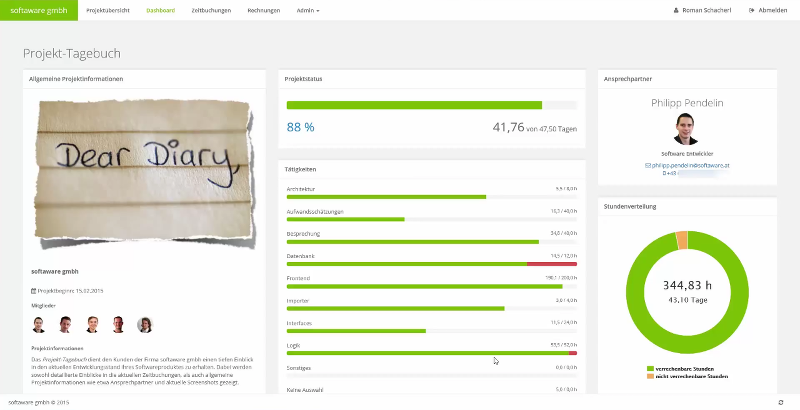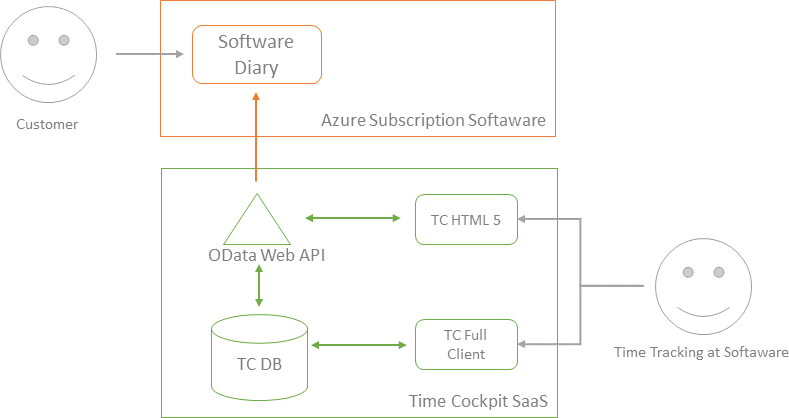
Granted, time tracking is not one of the favorite tasks of our customer. However, there are various reasons why most of us do not come around time tracking (see also article about six reasons for time tracking in agile projects). Here are some examples:
- Time tracking might be a legal obligation in your country.
- It helps you to learn from the past. If you track the time spent on a given task, it might help you to better estimate similar tasks in the future.
- Time tracking helps you to keep track of your projects and helps you to avoid project crisis.
- For a lot of us, time tracking is an absolute necessity, because as service providers we live from billing our time to customers. How should we know what to bill without accurate time tracking?
Financial Project Reports and Invoices are Important Communication Channels
We see a change of minds concerning the role and importance of financial project reporting in service companies. Instead of understanding time tracking and downstream processes like invoicing as just a necessary, annoying burden, it is turned into a success factor. One of our customers, Mr. Moser from BRAINWORX, found the right words (details):
"A lot of companies spend time and money on brochures and mailings, but only reach a small clientele. At the same time, they view invoicing as a tedious must. However, in a way, every offer, each project report or invoice is a business card of professionalism. These things need attention to give a customer the right picture of your company."
Softaware's Software Diary
Recently, our customer and partner softaware has launched its new product Software Diary. Today, it is a tool they use internally for interacting with their customers. Over time, Software Diary will become a product they offer to other companies, too.
Software Diary is not only a technical tool, it is a radical shift towards transparency. Agile projects need honest communication between customers and suppliers. The approach of softaware supports exactly that.
Let's look at what Software Diary covers and think about the organizational consequences of this approach afterwards.
Project Goal
Roman Schacherl, CEO of softaware, describes Software Diary like this:
"The codename for our new product is Software Diary. The main goal we wanted to achieve is to involve our customers in a much more transparent way. We want to give them live access to our timesheets and project status. In the past we have exported timesheets to Excel or we printed them. This is not the way we want to do customer interaction in the future.
So we created Software Diary. It starts with some general information about the project, the team members, contact data and so on. The customers also sees a gallery with images from the software. It visualizes the progress make on the UI side. At the beginning of the project it might just contain some early UI sketches. Over time, the customer sees how the solution evolves.
A core focus of Software Diary is the presentation of financial aspects of the project. The customers sees charts for things like spent development days compared to the overall budget, efforts grouped by activity, billable and non-billable (e.g. bug fixing) hours, and a chart with the distribution of development effort over time. We even plan to add a chart builder so that customers can tailor Software Diary to their specific needs.
Software Diary does not stop there. It even allows the customer to access all the details from softaware's time tracking system time cockpit. They can filter, sort, and export data to Excel so that they get financial project data in a format that fits their needs. This features saves customers and us a lot of time. They easily get what they need for their project controlling. We save time by not having to prepare and send status reports.
Last but not least we offer our customers access to all the invoices they received from us. Invoices are even linked to the time tracking detail data mentioned above so that customers can easily drill-down from invoice to time sheet records for checking the correctnes of our invoices."
Video
A picture is worth a thousand words. So here is a short video in which Roman introduces Software Diary:
Technical Implementation
For financial data like time sheet records and invoices, Software Diary accesses time cockpi's OData Web API behind the scenes. Accessing time cockpit live removes the need for a storing this data, importing it, scheduling the import process, etc.

Organizational Consequences
No question, what softaware has built is impressive from a technical standpoint. However, we think it is groundbreaking from an organizational perspective.
This level of transparency needs a very mature project management.
Here are some examples:
- Giving the user live access to time tracking data means that there is no chance to shift efforts from here to there at the end of the month.
- Not keeping time sheets up to date for weeks is no longer an option.
- Budget overruns become visible at a very early stage. They cannot be hidden or kept in the dark until the rude awakening at the end of the project.
- Quality of softaware's effort estimation is transparent to the customer.
- Visibility of data puts a pressure on users to keep data quality high (e.g. task description, project assignments).
Even in fixed price projects, this level of transparency provides value.
- The financial project status is visible to all team members. Somebody has to pay for budget overruns, even if it is not the customer. Software Diary sharpens the awareness of the entire team that efficiency and accurate effort estimations are important.
- When it comes to the next project, customer and supplier can have an honest discussion about prices and estimations based on the data of previous projects.
Concratulations, softaware. Your approach for financial project management and the level of transparency that you offer is impressive.
comments powered by